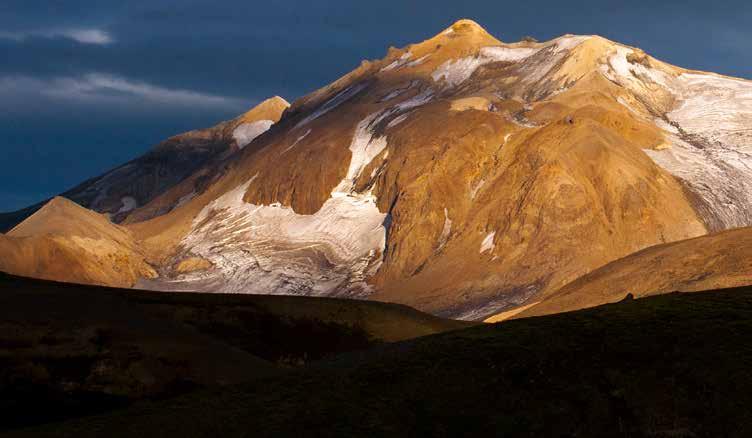
3 minute read
Where the Sun comes up
MJÓIFJÖRÐUR
It is possible to debate whether Klifbrekfossar in Mjóafjörður is the most beautiful waterfall in the country, that nowhere is the fog more awesome than in Stöðvarfjörður, or that the stillness on Eskifjörður is so complete, the silent and majestic mountains are reflected inverted on its mirror-like surface. But one thing is certain that the sun rises in Iceland first in Fjardabyggð, always.

Fjarðabyggð is the tenth most populous municipality in Iceland, with over five thousand residents in the middle of East Iceland, from Mjóafjörður in the north to Breiðdalsvík in the south. Fjarðabyggð was formed in 1998, about a quarter of a century ago, when Neskaupstaður, Eskifjörður and Reydarfjörður merged, followed by Mjóifjörður, Fáskrúðsfjörður, Stöðvarfjörður and Breiðdalsvík.
The fishing industry, aquaculture and the processing of marine products are the basic pillars of value creation in the municipality, as three of the larger fishery companies in the country are located in Fjarðabyggð. Then there is Alcoa-Fjarðaál, with its large aluminium smelter, in Reydarfjörður. The third pillar in the municipality is, of course, the tourism industry that has grown and grown rapidly in a short time, as the area is great for seeing and experiencing the uniqueness of Iceland year-round. Even in the winter, there is skiing in Oddsskarð, the sight of reindeer in the middle of the track, and enjoying the Northern Lights dancing above Skrúð, the island east of Vattarnes, between Reydarfjordur and Fáskrúðsfjörður.
The first protected nature conservancy of the country was established in Fjarðabyggð, in Neskaupstaður. The area around the foot of the Nipan mountain was protected in 1972. Since then, Hólmanes, between Eskifjörður and Reydarfjörður has also been designated a nature reserve. The Gerpis area, the easternmost part of Iceland, between Norðfjörður and Reydarfjörður is becoming one of the most popular hiking areas in Iceland, both because the area is deserted and because it is laid out with great, well-marked hiking trails, which makes it accessible to tourists and hikers alike. The nature and bird life in the area are exceptional.
What makes Fjarðabyggð especially exciting for tourists is its diversity. The tranquillity and beauty of Mjóafjörður is unforgettable, whether you take the sea route from Neskaupstaður or drive over the Mjófjarðarheiði pass. In contrast, Neskaupstaður bustles with energy. There is always life in the town, whether at the


FÁSKRÚÐSFJÖRÐUR FÁSKRÚÐSFJÖRÐUR

REYÐARFJÖRÐUR


ESKIFJÖRÐUR

museum at the harbour, or around the harbour itself. In Eskifjörður, old meets new charmingly in the fjord, creating a picturesque town. Reydarfjörður is the centre of the action, while at the bottom of the fjord between Vattarnes and Hafnarnes lies the town of Fáskrúðsfjörður, where you have to speak French! In the last century, the town was a centre for French fishing boats, fishing the wild Icelandic waters, as there are very good fishing grounds off the East coast. To the south is Stöðvarfjörður, where most travellers touring the country visit the unique and famous Petra’s Stone Collection. Continuing south, in Breiðdalsvík is Meleyri, one of the most beautiful coastlines in Iceland, a three kilometre-long beach with the Sæhvammstind mountains on one side and Sátur mountain with its distinctive peak, on the other. To see the sun kissing the land at dawn is stunning while, because Fjarðabyggð is Iceland’s most eastern municipality, naturally, most other people still only see a morning glow in the sky.
STÖÐVARFJÖRÐUR REYÐARFJÖRÐUR











